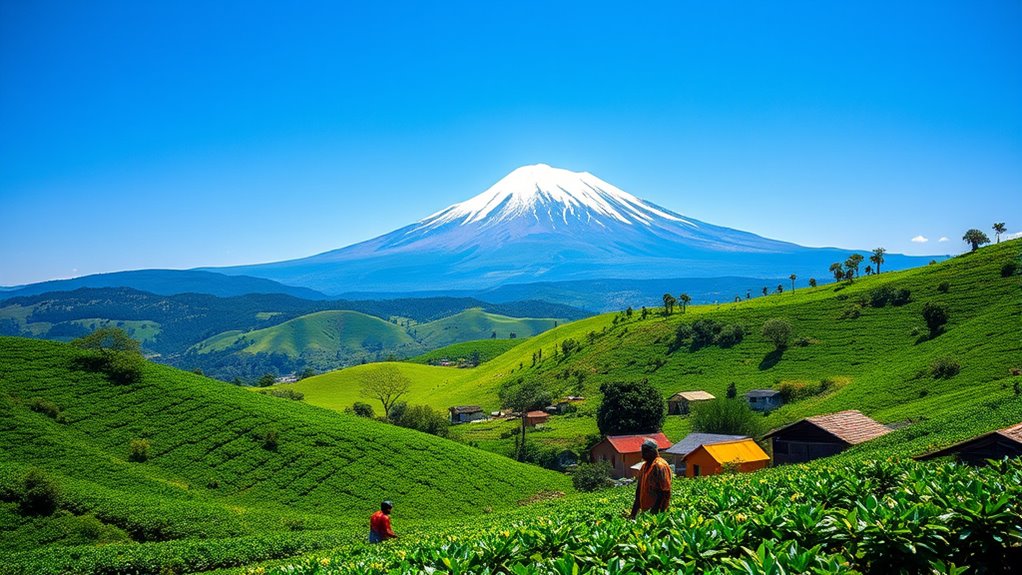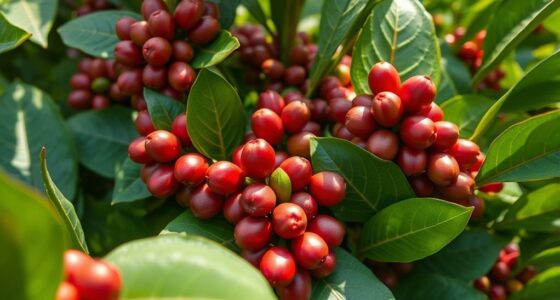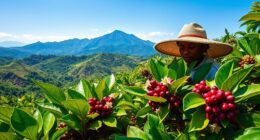Tanzania coffee from Kilimanjaro and Mbeya offers vibrant, complex flavors thanks to volcanic soils and high-altitude growth. You’ll notice bright acidity, fruity and floral notes, with smooth full-bodied textures depending on the brewing method. Careful cultivation and processing preserve the beans’ quality, showcasing craftsmanship from farm to cup. If you keep exploring, you’ll discover how regional differences influence each brew and what makes Tanzanian coffee truly unique.
Key Takeaways
- Kilimanjaro and Mbeya regions produce high-altitude Arabica beans with bright acidity and complex aromas due to volcanic soils.
- Coffee cultivation involves careful selection, nursery nurturing, and harvest at peak ripeness for superior quality.
- Processing methods like washed or wet techniques preserve the beans’ vibrant flavors before drying and sorting.
- Brewing techniques such as pour-over, French press, and espresso reveal different flavor nuances of Tanzanian coffee.
- The region’s unique environment and dedicated farmers contribute to the distinctive, high-quality coffee’s global reputation.

Are you curious about Tanzania’s renowned coffee? If so, you’re about to discover a world of rich flavors rooted in the country’s unique climate and terrain. Tanzania’s coffee cultivation thrives on the volcanic soils and high altitudes found in regions like Kilimanjaro and Mbeya, resulting in beans known for their bright acidity and complex aroma. When you explore Tanzania coffee, you’ll notice how the altitude and climate influence the beans’ character, producing a vibrant cup that stands out globally. Whether you’re a seasoned coffee enthusiast or just starting to explore specialty brews, understanding how coffee is cultivated here enhances your appreciation for each sip.
Discover Tanzania’s vibrant coffee, shaped by volcanic soils and high altitudes for bright, complex flavors.
In Tanzania, coffee cultivation is a meticulous process. Farmers often grow Arabica varieties, which flourish in the high elevations and well-drained volcanic soils. The process begins with selecting the best seeds and nurturing seedlings in nurseries before transplanting them into the fields. Throughout the year, farmers pay close attention to the timing of harvests, which typically occur when the cherries turn bright red and ripen uniformly. After harvesting, the beans undergo processing methods such as washed or wet processing, which help preserve their bright, crisp flavors. This careful cultivation and processing are crucial in producing the high-quality beans used by roasters around the world. Once harvested and processed, the beans are dried, sorted, and shipped to roasting facilities where their flavor profiles are further developed. Proper cultivation techniques play a vital role in maintaining the distinctive qualities of Tanzania coffee.
When it comes to brewing techniques, Tanzania’s coffee lends itself well to various methods, allowing you to enjoy its unique qualities fully. Pour-over brewing highlights the beans’ brightness and clarity, bringing out fruity and floral notes. A French press accentuates the full-bodied richness, giving you a more intense experience. Espresso brewing emphasizes the beans’ aromatic complexity, perfect for those who enjoy a concentrated shot packed with flavor. No matter which method you choose, freshly ground Tanzania coffee will deliver a vibrant, nuanced taste. To get the most out of your brew, confirm your water temperature is just right—around 195 to 205 degrees Fahrenheit—and use freshly ground beans. Experimenting with brewing times can also reveal different facets of the coffee’s personality, from lively acidity to smooth, lingering finishes.
In essence, Tanzania offers a coffee experience that combines rich cultivation traditions with versatile brewing techniques. By understanding the journey from bean to cup, you gain a deeper appreciation for the care and craftsmanship involved. Whether you prefer a bright drip or a robust espresso, Tanzania’s coffee promises a memorable, flavorful journey that celebrates its unique origins. So next time you sip your brew, remember the vibrant landscapes and dedicated farmers behind every cup, and enjoy the rich story woven into each sip.
Frequently Asked Questions
What Are the Best Times of Year to Visit Kilimanjaro and Mbeya for Coffee Tours?
You should visit Kilimanjaro and Mbeya during the dry seasons, typically from June to October and December to February, when the seasonal climate is ideal for coffee tours. During these months, the tourist influx is manageable, and the weather is clear, making it easier to explore coffee farms. Avoid the rainy seasons, as heavy rains can disrupt tours and affect the coffee plants’ visibility, reducing your overall experience.
How Do Local Tanzanian Coffee Farming Practices Differ Between Kilimanjaro and Mbeya?
You’ll notice that farming techniques differ between Kilimanjaro and Mbeya due to altitude differences. On Kilimanjaro, farmers often use traditional methods, focusing on shade-grown coffee at higher elevations, which enhances flavor. In Mbeya, farmers utilize more diverse techniques, including intercropping and organic practices, thanks to its varied terrain. These differences influence coffee quality, with Kilimanjaro’s coffee being more nuanced and Mbeya’s offering robust, earthy flavors.
Are There Any Unique Coffee Varieties Exclusive to Kilimanjaro or Mbeya Regions?
Imagine tasting a coffee unique to Kilimanjaro’s high-altitude regions—here, you find altitude-specific varieties like Kilimanjaro AA, which boasts a bright, citrusy flavor. In contrast, Mbeya’s volcanic soils produce distinct regional flavor profiles, with varieties like Mbeya Peaberry delivering a richer, full-bodied taste. These exclusive varieties showcase how altitude and terroir create one-of-a-kind coffees, making each region’s brew truly special and memorable for you.
What Sustainable Farming Initiatives Are Present in Tanzania’s Coffee-Growing Areas?
You’ll find several sustainable farming initiatives in Tanzania’s coffee-growing areas, including organic certification and fair trade programs. These efforts help promote environmentally friendly practices, improve farmers’ livelihoods, and guarantee ethical trading. By participating in organic certification, farmers reduce chemical use, while fair trade programs assure fair wages and community development. These initiatives work together to support sustainable coffee production, benefiting both farmers and the environment in regions like Kilimanjaro and Mbeya.
Can Tourists Participate in Coffee Harvesting or Processing Activities in These Regions?
Yes, you can participate in coffee harvesting experiences and farm tours in these regions. Tourists often get the chance to join local farmers during harvesting, helping pick ripe cherries and learning about processing methods. These coffee farm tours offer an immersive experience, allowing you to see firsthand how Tanzania’s coffee is grown and processed. It’s a unique way to connect with the culture and support sustainable farming practices.
Conclusion
As you explore Tanzania’s vibrant coffee regions like Kilimanjaro and Mbeya, remember that “a journey of a thousand miles begins with a single step.” Embrace the rich flavors and unique stories behind each cup, and let the beauty of these landscapes enhance your experience. Whether you’re savoring a brew or learning about its origin, enjoy every moment. After all, the best things in life are brewed with passion and patience.








